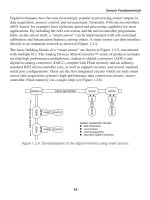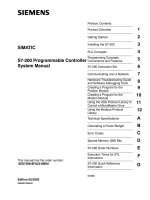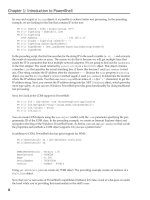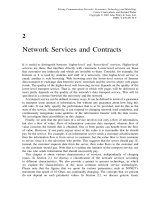Tài liệu MicroSim PSpice A/D (P2) ppt
Bạn đang xem bản rút gọn của tài liệu. Xem và tải ngay bản đầy đủ của tài liệu tại đây (264.96 KB, 20 trang )
Commands
standard analyses
.AC (AC Analysis)
.DC (DC Analysis)
.FOUR (Fourier Analysis)
.NOISE (Noise Analysis)
.OP (Bias Point)
.SENS (Sensitivity Analysis)
.TF (Transfer)
.TRAN (Transient Analysis)
output control
.PLOT (Plot)
.PRINT (Print)
.PROBE (Probe)
.VECTOR (Digital Output)
.WATCH (Watch Analysis Results)
simple multi-run analyses
.STEP (Parametric Analysis) .TEMP (Temperature)
circuit file processing
.END (End of Circuit)
.FUNC (Function)
.INC (Include File)
.LIB (Library File)
.PARAM (Parameter)
statistical analyses
.MC (Monte Carlo Analysis)
.WCASE
(Sensitivity/ Worst-Case Analysis)
device modeling
.ENDS (End Subcircuit)
.DISTRIBUTION
(User-Defined Distribution)
.MODEL (Model)
.SUBCKT (Subcircuit)
initial conditions
.IC (Initial Bias Point Condition)
.LOADBIAS (Load Bias Point File)
.NODESET
(Set Approximate Node Voltage for Bias Point)
.SAVEBIAS (Save Bias Point to File)
miscellaneous
.ALIASES, .ENDALIASES
(ALIASES and ENDALIASES)
.EXTERNAL (External Port)
.OPTIONS (Analysis Options)
.STIMLIB (Stimulus Library File)
.STIMULUS (Stimulus)
.TEXT (Text Parameter)
* (Comment)
; (In-line Comment)
+ (Line Continuation)
Commands Command Reference for PSpice and PSpice A/D
1-2
Command Reference
for PSpice and PSpice A/D
Schematics users enter analysis specifications through the Analysis Setup dialog box (from
the Analysis menu, select Setup).
Function PSpice Command Description
standard analyses .AC (AC Analysis)
.DC (DC Analysis)
.FOUR (Fourier Analysis)
.NOISE (Noise Analysis)
.OP (Bias Point)
.SENS (Sensitivity Analysis)
.TF (Transfer)
.TRAN (Transient Analysis)
frequency response
DC sweep
Fourier components
noise
bias point
DC sensitivity
small-signal DC transfer function
transient
simple multi-run
analyses
.STEP
(Parametric Analysis)
.TEMP (Temperature)
parametric
temperature
statistical analyses .MC
(Monte Carlo Analysis)
.WCASE (Sensitivity/Worst-Case
Analysis)
Monte Carlo
sensitivity/worst-case
initial conditions .IC
(Initial Bias Point Condition)
.LOADBIAS (Load Bias Point File)
.NODESET (Set Approximate Node
Voltage for Bias Point)
.SAVEBIAS (Save Bias Point to File)
clamp node voltage for bias point calculation
to restore a .NODESET bias point
to suggest a node voltage for bias calculation
to store .NODESET bias point information
device modeling .ENDS
(End Subcircuit)
.DISTRIBUTION (User-Defined Distri
bution)
.MODEL (Model)
.SUBCKT (Subcircuit)
end of subcircuit definition
model parameter tolerance distribution
modeled device definition
to start subcircuit definition
output control .PLOT
(Plot)
.PRINT (Print)
.PROBE (Probe)
.VECTOR (Digital Output)
.WATCH (Watch Analysis Results)
to send an analysis plot to output file
(line printer format)
to send an analysis table to output file
to send simulation results to Probe data file
digital state output
view numerical simulation results in progress
1-3
Commands Command Reference for PSpice and PSpice A/D
circuit file
processing
.END (End of Circuit)
.FUNC (Function)
.INC (Include File)
.LIB (Library File)
.PARAM (Parameter)
end of circuit simulation description
expression function definition
include specified file
reference specified library
parameter definition
miscellaneous .ALIASES,
.ENDALIASES (ALIASES
and ENDALIASES)
.EXTERNAL (External Port)
.OPTIONS (Analysis Options)
.STIMLIB (Stimulus Library File)
.STIMULUS (Stimulus)
.TEXT (Text Parameter)
* (Comment)
; (In-line Comment)
+ (Line Continuation)
to begin and end an alias definition
to identify nets representing the outermost (or
peripheral) connections to the circuit being
simulated
to set miscellaneous simulation limits,
analysis control parameters, and output
characters
to specify a stimulus library name containing
.STIMULUS information
stimulus device definition
text expression, parameter, or file name used
by digital devices
to create a comment line
to add an in-line comment
to continue the text of the previous line
Function PSpice Command Description
Commands .AC (AC Analysis)
1-4
.AC
(AC Analysis)
Purpose
The .AC command calculates the frequency response of a circuit over a range of frequencies.
General Form
.AC <sweep type> <points value>
+ <start frequency value> <end frequency value>
Examples
.AC LIN 101 100Hz 200Hz
.AC OCT 10 1kHz 16kHz
.AC DEC 20 1MEG 100MEG
Arguments and Options
<sweep type>
Must be LIN, OCT, or DEC, as described below.
Parameter Description Description
LIN linear sweep The frequency is swept linearly from the
starting to the ending frequency. The
<points value> is the total number of points in
the sweep.
OCT sweep by octaves The frequency is swept logarithmically by
octaves. The <points value> is the number of
points per octave.
DEC sweep by decades The frequency is swept logarithmically by
decades. The <points value> is the number of
points per decade.
<points value>
Specifies the number of points in the sweep, using an integer.
<start frequency value> <end frequency value>
The end frequency value must not be less than the start frequency value, and both must be
greater than zero. The whole sweep must include at least one point. If a group delay (G
suffix) is specified as an output, the frequency steps must be close enough together that
the phase of that output changes smoothly from one frequency to the next. Calculate group
delay by subtracting the phases of successive outputs and dividing by the frequency
increment.
Comments
A .PRINT (Print), .PLOT (Plot), or .PROBE (Probe) command must be used to get the
results of the AC sweep analysis.
AC analysis is a linear analysis. The simulator calculates the frequency response by
linearizing the circuit around the bias point.
All independent voltage and current sources that have AC values are inputs to the circuit.
During AC analysis, the only independent sources that have nonzero amplitudes are those
using AC specifications. The SIN specification does not count, as it is used only during
transient analysis.
To analyze nonlinear functions such as mixers, frequency doublers, and AGC, use
.TRAN
(Transient Analysis).
1-5
Commands .ALIASES, .ENDALIASES (ALIASES and ENDALIASES)
.ALIASES,
.
ENDALIASES
(ALIASES and ENDALIASES)
Purpose
The Alias commands set up equivalences between node names and pin names, so that traces
in the Probe display can be identified by naming a device and pin instead of a node. They are
also used to associate a net name with a node name.
General Form
.ALIASES
<device name> <device alias> (<<pin>=<node>>)
_ _ (<<net>=<node>>)
.ENDALIASES
Examples
.ALIASES
R_RBIAS RBIAS (1=$N_0001 2=VDD)
Q_Q3 Q3 (c=$N_0001 b=$N_0001 e=VEE)
_ _ (OUT=$N_0007)
.ENDALIASES
The first alias definition shown in the example allows the name RBIAS to be used as an alias
for R_RBIAS, and it relates pin 1 of device R_RBIAS to node $N_0001 and pin 2 to VDD.
The last alias definition equates net name OUT to node name $N_0007.
Commands .DC (DC Analysis)
1-6
.DC
(DC Analysis)
Purpose
The .DC command performs a linear, logarithmic, or nested DC sweep analysis on the circuit.
The DC sweep analysis calculates the circuit’s bias point over a range of values for
<sweep variable name>.
Sweep Type
The sweep can be linear, logarithmic, or a list of values.
Parameter Description Meaning
LIN linear sweep The sweep variable is swept linearly from the
starting to the ending value.
OCT sweep by octaves Sweep by octaves. The sweep variable is swept
logarithmically by octaves.
DEC sweep by decades Sweep by decades. The sweep variable is swept
logarithmically by decades.
LIST list of values Use a list of values.
1-7
Commands .DC (DC Analysis)
Linear Sweep
Lo
garithmic Sweep
General Form
.DC [LIN] <sweep variable name>
+ <start value> <end value> <increment value>
+ [nested sweep specification]
Examples
.DC VIN -.25 .25 .05
.DC LIN I2 5mA -2mA 0.1mA
.DC VCE 0V 10V .5V IB 0mA 1mA 50uA
.DC RES RMOD(R) 0.9 1.1 .001
Arguments and Options
<start value>
Can be greater or less than <end value>: that is, the sweep can go in either direction.
<increment value>
The step size. This value must be greater than zero.
Comments
The sweep variable is swept linearly from the starting to the ending value.
The keyword LIN is optional.
General Form
.DC <logarithmic sweep type> <sweep variable name>
+ <start value> <end value> <points value>
+ [nested sweep specification]
Examples
.DC DEC NPN QFAST(IS) 1E-18 1E-14 5
Arguments and Options
<logarithmic sweep type>
Must be specified as either DEC (to sweep by decades) or OCT (to sweep by octaves).
<start value>
Must be positive and less than <end value>.
<points value>
The number of steps per octave or per decade in the sweep. This value must be an integer.
Comments
Either
OCT
or
DEC
must be specified for the <logarithmic sweep type>.
Commands .DC (DC Analysis)
1-8
Nested Sweep
General Form
.DC <sweep variable name> LIST <value>*
+[nested sweep specification]
Examples
.DC TEMP LIST 0 20 27 50 80 100 PARAM Vsupply 7.5 15 .5
Arguments and Options
<sweep variable name>
After the DC sweep is finished, the value associated with <sweep variable name> is set
back to the value it had before the sweep started. The following items can be used as sweep
variables in a DC sweep:
Parameter Description Meaning
Source A name of an independent
voltage or current source.
During the sweep, the source’s voltage or
current is set to the sweep value.
Model
Parameter
A model type and model
name followed by a model
parameter name in
parenthesis.
The parameter in the model is set to the
sweep value. The following model
parameters cannot be (usefully) swept: L
and W for the MOSFET device (use LD
and WD as a work around), and any
temperature parameters, such as TC1 and
TC2 for the resistor.
Temperature Use the keyword TEMP for
<sweep variable name>.
Set the temperature to the sweep value.
For each value in the sweep, all the
circuit components have their model
parameters updated to that temperature.
Global
Parameter
Use the keyword PARAM,
followed by the parameter
name, for
<sweep variable name>.
During the sweep, the global parameter’s
value is set to the sweep value and all
expressions are reevaluated.
Comments
For a nested sweep, a second sweep variable, sweep type, start, end, and increment values can
be placed after the first sweep. In the nested sweep example, the first sweep is the inner loop:
the entire first sweep is performed for each value of the second sweep.
When using a list of values, there are no start and end values. Instead, the numbers that follow
the keyword LIST are the values that the sweep variable is set to.
The rules for the values in the second sweep are the same as for the first. The second sweep
generates an entire .PRINT
(Print) table or .PLOT (Plot) plot for each value of the sweep.
Probe displays nested sweeps as a family of curves.









